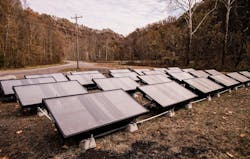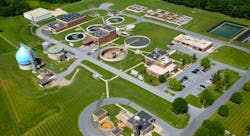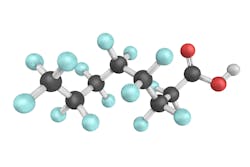WaterWorld Newscast - Dec. 9, 2019
The following is a transcript of the WaterWorld Newscast for the week of Dec. 9, 2019
Hi, I'm Angela Godwin for WaterWorld magazine, bringing you water and wastewater news headlines for the week of December 9. Coming up...
- Fatberg suspected in New York sewer backup
- Solar-powered Hydropanels supply water for rural W.V. community
- Waste-to-energy upgrades will reduce carbon footprint for Hershey wastewater plant
- Slippery toilet saves water with cleaner flush
- The Evolving landscape of PFAS, with special guest Battelle's Amy Dindal
Amy, Battelle has been researching PFAS and its effects for over a decade. What have you learned?
[AMY DINDAL] You're welcome, Angela. Thank you for having me.
Amy, Battelle has been researching PFAS and its effects for over a decade. What have you learned?
[AMY DINDAL] As a 501(c)(3) non-profit, we really have at our core mission of science for societal benefit. So this complex issue of PFAS really fits within our DNA. We've been investing significantly over the last year in particular, looking at different technologies and solutions for PFAS whether it be remediation, monitoring, or assessment. And what we've learned is that these substances are significantly different than other environmental contaminants that we've had to deal with in the past. It's that carbon-fluorine bond that makes them so useful in so many different applications which also makes them very difficult to remediate.
Earlier this year, Battelle received accreditation for testing four new PFAS compounds in its lab in Massachusetts, making it the leading PFAS testing lab in the country. What are some of the lab's capabilities?
[AMY DINDAL] It's interesting because the analysis of PFAS continues to be an evolving landscape -- with the ever-changing regulations and different PFAS compounds that we're targeting -- that changes the methods and the qualities that go into those methods and different requirements that we have. The other thing that's challenging about this is the different matrices that are there to be looked at. We have traditional matrices like groundwater and soil and sediment, but because of the interest in PFAS and how it's entering our environment, there are things like landfill leachate and biosolids, which are much more complex. Our laboratory there, as you mentioned, in Norwell, Mass., it is an accredited laboratory that can work nationwide for the Department of Defense, and we also have accreditation in many other states as well. And as a research organization, we are also focused on doing method optimization and new method development. In fact, at our Columbus, Ohio, headquarters, we're working on things like developing signatures of PFAS in different source materials and also developing assays to look at total fluorine and total PFAS in different environmental matrices.
As you mentioned earlier, we know that the properties that make PFAS so useful also make them nearly impossible to remove. How can water and wastewater treatment providers hope to address this water quality challenge?
[AMY DINDAL] It's interesting because water and wastewater treatment providers are in a very difficult position because they are secondary receivers of the PFAS compounds; they're not using them themselves or generating them as part of the projects that they're doing, but it's rather the source of the materials that they're receiving are containing the PFAS materials. So fortunately for drinking water treatment, some of the traditional techniques that are used for treating other contaminants, like granular activated carbon or ion exchange resins, they can be used for looking at PFAS. In the case of the wastewater treatment processes, there are some continuing concerns about what happens with those materials in the end. Incineration is a process that's used for treating those materials, but it's not known yet if there's really a deleterious effect that's happening, whether the PFAS are really truly being destroyed or not. So it's much more of a challenge from that perspective.
We know that these chemicals are persistent and accumulate in soil. What else do we know about the fate and transport of PFAS compounds and how contaminated sites can be remediated?
[AMY DINDAL] First and foremost, it's important to understand that there are almost 5,000 compounds in the class, and a lot is known about two of those compounds: PFOA and PFOS. So there is still a lot to learn and understand about it. But in general from a fate and transport standpoint, these compounds do show greater migration away from the source area and they also have more complex interactions in the environment. So it is a challenge, definitely, to deal with these compounds as opposed to other traditional contaminants that we see. Fortunately, there is a lot being done in terms of collaboration and understanding the information that's available and it's being shared with organizations like the Interstate Technology and Regulatory Council, who are producing fact sheets and sharing information so that we can at least gain some knowledge together and leverage the information that's being produced in the industry.
What is the future of PFAS research? Where are you focusing efforts right now?
[AMY DINDAL] Our priority right now is focused on complete destruction of PFAS. Those traditional approaches that I mentioned earlier -- granular activated carbon and ion exchange resins -- they transfer the PFAS material from one source to another, so you still have to address the PFAS in the materials that are absorbing them. So what we're focused on is complete destruction of the PFAS compounds (as is the industry as a whole). So, we're very encouraged by some results that we have and we're hoping to be able to share more very early in 2020. Another focus for us is the incineration area and the thermal treatment of PFAS. I mentioned that earlier as well, that there is a concern about what really is happening to these materials as they are being remediated through incineration. Are the PFAS truly being destroyed? Or are PFAS residuals remaining, such that they are in the ash or potentially being redeposited on the surrounding environment through the flue gas emissions. That's a very important area of research that we're working on as well.
All the work you're doing right now is so important to our industry and to public health as well, and we wish you all the best of luck with that. Thank you so much for joining us today.
[AMY DINDAL] Thank you, Angela.
For WaterWorld magazine, I'm Angela Godwin. Thanks for watching.




